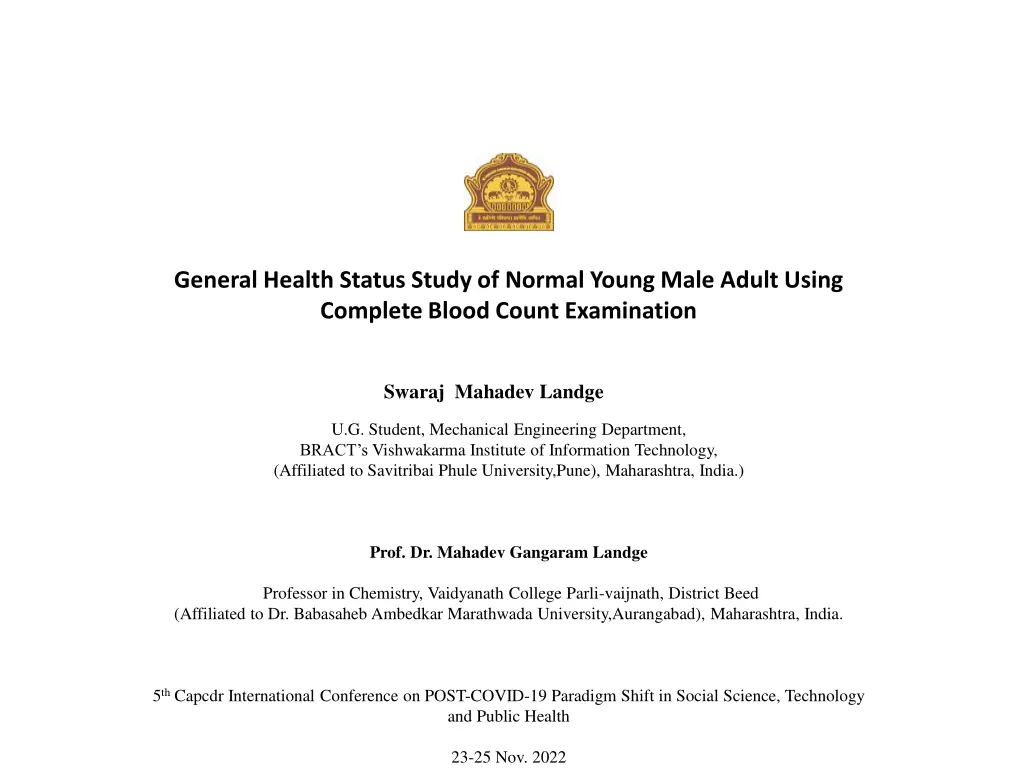
Insight into White Blood Cells and Health Status Study
Explore the significance of white blood cells in maintaining optimal health through a study of a normal young male adult using complete blood count examination. Understand the physiological mechanisms of cells and promote awareness of complete blood count tests, aiming to diagnose medical conditions and monitor treatment effectively.
Download Presentation

Please find below an Image/Link to download the presentation.
The content on the website is provided AS IS for your information and personal use only. It may not be sold, licensed, or shared on other websites without obtaining consent from the author. If you encounter any issues during the download, it is possible that the publisher has removed the file from their server.
You are allowed to download the files provided on this website for personal or commercial use, subject to the condition that they are used lawfully. All files are the property of their respective owners.
The content on the website is provided AS IS for your information and personal use only. It may not be sold, licensed, or shared on other websites without obtaining consent from the author.
E N D
Presentation Transcript
General Health Status Study of Normal Young Male Adult Using Complete Blood Count Examination Swaraj Mahadev Landge U.G. Student, Mechanical Engineering Department, BRACT s Vishwakarma Institute of Information Technology, (Affiliated to Savitribai Phule University,Pune), Maharashtra, India.) Prof. Dr. Mahadev Gangaram Landge Professor in Chemistry, Vaidyanath College Parli-vaijnath, District Beed (Affiliated to Dr. Babasaheb Ambedkar Marathwada University,Aurangabad), Maharashtra, India. 5th Capcdr International Conference on POST-COVID-19 Paradigm Shift in Social Science, Technology and Public Health 23-25 Nov. 2022
INTRODUCTION White Blood Cells as the Armed Forces of the Body An attempt has been made to study the general health status of normal adult patient using complete blood count. The number of tests such as Red blood cell count, White blood cell count, Abs. Eosinophil count, Packed cell volume, Mean corpuscular volume, Mean corpuscular hemoglobin, Mean corpuscular Hb concentration, Red cell distribution width, Neutrophils, Lymphocytes, Eosinophil, Monocytes, Basophils, Platelets,Hemoglobin, Hematocrit, etc were done on Semi Automatic Analyzer. The abnormal increases or decreases in cell counts as revealed in a CBC may show that the patient underlying medical condition that calls for further examination. The results of these tests observed were used to advice the patient health status and diagnose a medical condition to monitor medical treatment. The observations of tests were compared with known reference value range, which may show positive or negative divergence with child stage, young stage, old age stage and also with male-female difference in sex. The positive deviation of means corpuscular volume and negative deviation of mean corpuscular Hb concentration were well explained.
Objective * To discuss blue print of blood tests. * To study the physiological mechanism of cells. * To know the health status of patient. * To promote the awareness of CBC.
The cells in the CBC (WBC, RBC and Platelets) have special unique functions. In general way of condition the white blood cells or leukocytes are mainly the important part of the immune system and help to fight against the infections by attacking bacteria, viruses and germs that caused due to different unfavorable conditions invade the body. Each and every component of WBC plays vital role in increasing the power of immune system. The WBC originates in the bone marrow but circulate throughout the bloodstream. A WBC count can find hidden infections of patient body and give alarm to doctors to un diagnosed medical conditions, such as autoimmune diseases, immune deficiencies and blood disorders. The important application of WBC tests are found supportive study in cancer treatment also. Many medicinal study shows that the infants are often born with much higher number of WBC. There are five major types of white blood cells. According to the Leukmia and Lumphoma Society (LLS), the normal percentage of WBC count are usually found in following ranges.
The platelets or thrombocytes are tiny, colorless cell fragments in our blood that forms clots and prevent or stop bleeding. If due to some accident our blood vessels get rupture or damaged, then it send signals or message to the platelets, which immediately rushes to the particular site of damage and forms plug or clot to fix or adhere the damage. If by some underlying medical condition patient don t have enough platelets in blood, then body can t forms so required clots. In medical term low platelet count may also called thrombocytopenia, i.e. infections with protozoa, bacteria, and viruses which may range from mild to severe depending upon illness caused to patient. In such condition, doctor suggests generally following balanced things to increase the blood platelets count as, eating leafy vegetables, fatty fish, citrus, iron rich foods, use of chlorophyll supplement, folate rich foods, food rich vitamin B-12, C, D, K and avoiding alcohols, vitamin E and fish oil supplements etc.
Literature survey reveals that the lower or higher numbers of WBC than normal can be a sign of an underlying medical condition. The symptoms of a low WBC count includes body aches, fever, chills, headaches etc, while high counts don t often shows any symptoms. The leukopenia is the medical term used to describe a low WBC count, on other hand, the leukocytosis is the medical term used to describe a high WBC count. No specific diet or food increase WBC count in the patient body, but vitamin B-12 and folate are also required to produce the WBC. Generally the doctor s advice the good source of protein diet plan with multivitamins and mineral supplements. The doctor s mainly suggested 15 foods that boosts the immune system are citrus fruits, garlic, spinach, ginger, almonds, turmeric, yogurt, red bell peppers, sunflower seeds, poultry, kiwi, papaya, green tea, shellfish, broccoli etc. Red blood cells (RBC), also known as erythrocytes or haematids, or erythroid cells deliver fresh oxygen to the tissues in our body via blood flow through the circulatory system converted into energy and our tissues release carbon dioxide to lungs for exhale. They are made in bone marrow and with richest source of proteins. The RBC typically live for about 120 days and then die. The structure of RBC are round with a flattish, intented center like doughnuts without a hole. The food rich in iron help to maintain healthy RBC. Generally, vitamins B-12, B-3 found in eggs, whole grains and bananas are needed to build healthy RBC. Also the folate found in fortified cereals, dry beans, lentils, orange juice, and green leafy vegetables are the good sources for the supplement of RBC.
Conclusion The complete blood counts refers for variety of reasons, i.e. to review patients normal health, to diagnose a medical conditions, to monitor a medical underlying, to check overall medical treatment such as an anemia, leukemia, weakness, fatigue, fever, inflammation, brushing bleeding, thalassemia, nutritional deficiencies, sickle cell disease, hemoglobin abnormalities, dehydration, bone marrow disorder etc.






